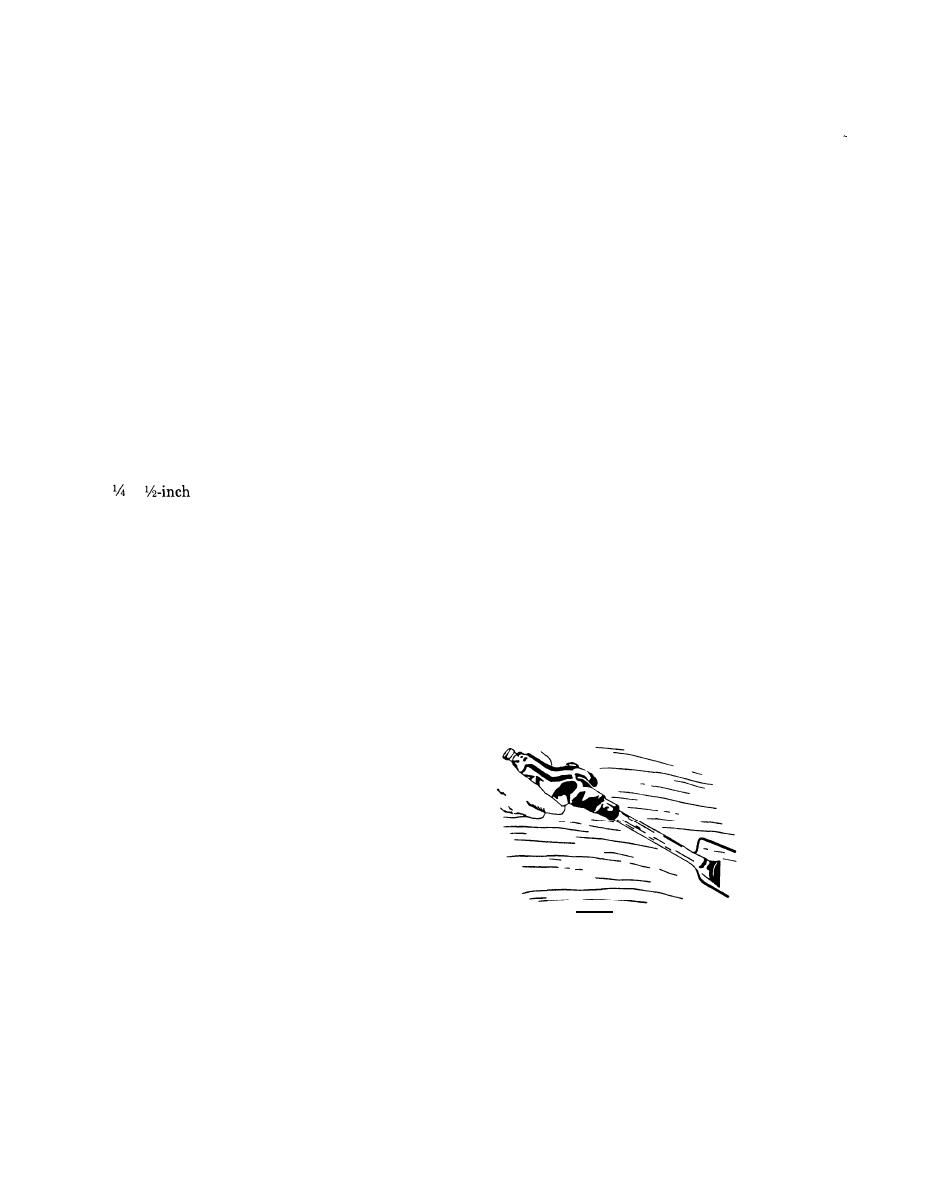

Custom Search
|
|

|
||
 TM 5-684/NAVFAC MO-200/AFJMAN 32-1082
at several positions about 2 feet (0.6 meters) above
tion of preservative, wrapping of the treated area,
the ground line. Allow the liquid to run slowly over
soil sterilization, and backfilling.
a. Excavation. The excavation should be deep
the pole and into all crevices. Let the excess accu-
enough to expose the affected area and wide enough
mulate in the trench. All of the pole surface should
to permit safe and efficient working conditions. The
be covered by the preservative, from the bottom of
trench dug for the inspection will normally be satis-
the excavation to about 2 feet (0.6 meters) above the
factory. When there is any possibility that digging
ground line.
will affect the stability of the pole, temporary guys
or pikes should be installed. Remove all debris from
tamp well. Then make another narrow trench 4 or 5
the excavation.
inches (100 to 130 millimeters) deep around the pole
b. Cleaning. The removal of all soft or decayed
and fill this with more preservative. Use any re-
wood, at and below the ground line, with a spade
maining backfill to cover this trench. Tamp and
and wire brush during inspection must be followed
mound to provide required bearing strength and
by wire brushing to expose a clean surface of sound
avoid depressions. See section IV for methods and
wood. Treatment should immediately follow the in-
materials for providing extra pole-bearing strength.
spection.
(c) Active decay. In poles containing active
decay, a desirable addition to the above treatment is
servative available for groundline treatment of
to use an approved water-soluble pesticide as a first
poles are compounds or liquid solutions applied to
application. This will diffuse into the wood and is
the pole and sterilization of the soil.
effective in killing or arresting internal decay that
(1) Compounds. Preservative compounds in the
may not be reached by the preservative. A pesti-
form of approved pastes, gels, or greases can be
applied in to
(6 to 13 millimeter) layers by
cide's usefulness is of short duration, however, as it
means of a trowel or spatula. Start at the bottom of
is ineffective as a preservative alone. Sprinkle about
the trench and continue upward about 6 inches (150
one pound (0.5 kilograms) of dry pesticide against
millimeters) above the ground line. Power equip-
and all around the pole surface just before applying
ment consisting of a pump, hose and flattened
the preservative. Most of it should be applied below
nozzle, as shown in figure 4-9, will be a good invest-
___
the ground line and none of it should be exposed
ment if a large number of poles are to be treated.
after backfilling. Precautions are necessary to avoid
After the preservative has been applied, cover the
any danger of poisoning persons or livestock by
treated area with a grease-resistant material to pre-
leaving pesticide lying about. Pesticide should be
vent the compound from diffusing into the soil. Cel-
bought in l-pound (0.5 kilogram) cartons and each
lophane, polyethylene film, or treated Kraft paper
empty carton should be disposed of in the hole be-
may be used, but care must be taken to prevent
fore backfilling.
puncture or displacement by sharp stones, shovels,
or tampers during backfill. The effectiveness of the
treatment is dependent on the integrity of the cov-
ering.
(2) Liquid solutions. Treatment per pole will
usually require 2 to 3 gallons (8 to 12 liters) of
approved preservative solution.
(a) Initial backfill. Refill the excavation
about half-way. With the blade of the shovel or
spade make a V-shaped trench around the pole
down to the original depth of the excavation. (This
avoids using excess preservative by containing it
close to the pole.) Then pour a liberal amount of the
preservative all over and around the pole surface by
placing the mouth of the container against the pole
Figure 4-9. Nozzle for application of a compound preservative
Section VII - METAL POLES
4-25. Metal pole usage.
rigid structure and thus eliminate the need for guys
and anchors. Aluminum is used where its strength
Some structures and most bolts and attachments
is adequate and where resistance to corrosion is
are of metal. Steel is used where strength is the
important. See also chapter 3, section II.
major requirement. Steel poles can be used in a
4-14
|
 |
|
 |
||